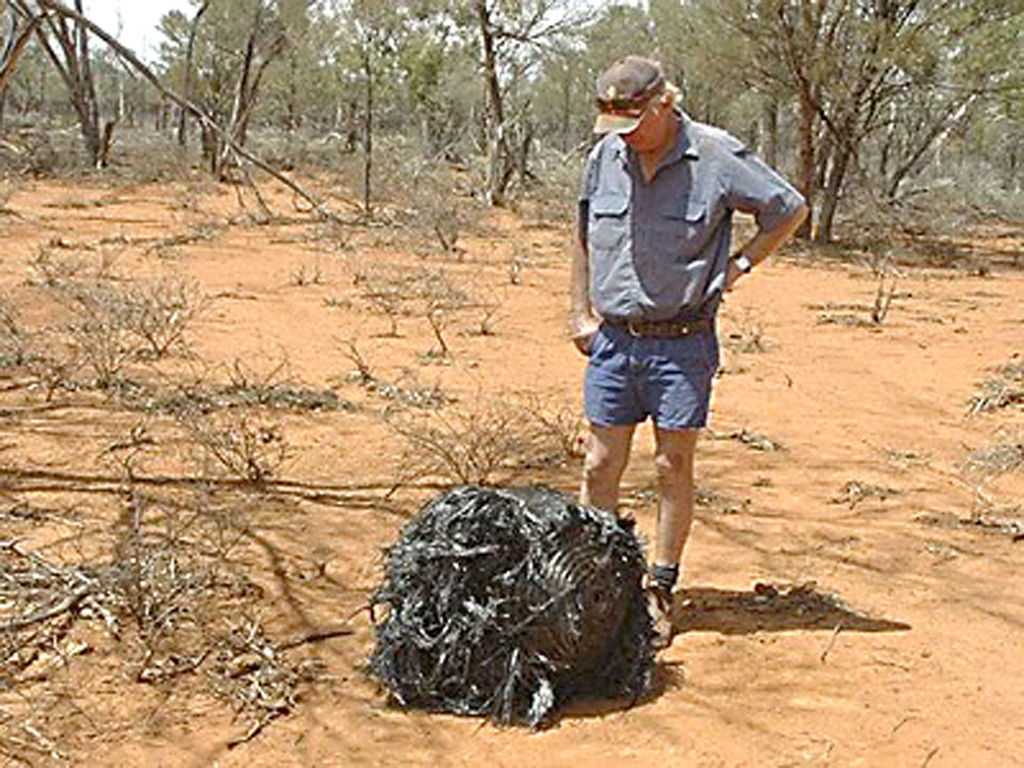More space debris falling to Earth
“Well, here it is,” said aerospace engineer William Ailor as he paused next to the hulking metal shells arrayed along the plaza outside a visitor entrance at Aerospace Corp.’s El Segundo, Calif., headquarters.
The stuff is junk. But, Ailor said, it’s no ordinary junk. This garbage has traveled to space and back.
A 150-pound hollow sphere of blackened titanium is all that remains of a motor casing from a Delta II rocket that fell to Earth in 2001, landing in the Saudi Arabian desert west of Riyadh.
A 600-pound stainless-steel fuel tank, also from a Delta II rocket, sits nearby, dented, gashed and rusty — scarred by its descent from space to a farm near Georgetown, Texas, in 1997.
An artist once asked if he could use the mangled metal in a sculpture. (It was Air Force property, so the answer was no.) Ailor said he has occasionally worried about thieves dragging the tanks off to sell as scrap.
But he and the dozen or so researchers he works with at Aerospace Corp.’s Center for Orbital and Reentry Debris Studies, or CORDS, where he is the principal scientist, usually don’t concern themselves with space trash’s artistic or monetary value. They’re interested in the science of it — and in safety.
“We worry about orbital debris,” Ailor said.
Aerospace Corp. is a nonprofit research and development organization that provides technical advice to the military, NASA and other government and commercial customers. The job of Ailor’s group is to see how space debris affects satellites and what hazards it poses when it re-enters the atmosphere. CORDS also publishes predictions of when larger items might crash to Earth so that some debris might be recovered and returned for analysis.
It is the only group in the world that systematically brings fallen space junk back to the laboratory for testing, Ailor said.
Over 37 years, the researchers have collected about 10 or so samples of the detritus, including the Delta rocket components, in an effort to better understand how scraps in space behave when they reenter Earth’s atmosphere.
The team analyzes the size and shape of the debris and uses sophisticated computer programs to reconstruct its fall to the ground. It examines melted holes and compositional properties of the found metal to estimate how much heating the space junk underwent during re-entry — which tells scientists the maximum temperatures reached and helps explain why these types of objects survive.
The hope is to keep satellites, and people, from harm.
There are more than 22,000 pieces of space debris larger than 4 inches orbiting the Earth, and millions of other items in orbit that are too small to be tracked with precision, according to a 2011 report commissioned by NASA.
Even tiny bits of debris, like paint chips, can damage satellites and manned spacecraft when they’re traveling in low-Earth orbit at around 21,600 mph. An aluminum sphere half an inch in diameter has the potential to do as much damage upon collision as a 400-pound safe traveling at 60 mph. Larger items like defunct satellites can pulverize the objects they hit in space, generating ever more pieces of dangerous floating trash.
Debris could potentially hurt humans. In just the last four months, three very large spacecraft, including the failed Russian Mars lander Phobos-Ground, have plunged to Earth. To date, no one has been injured, thanks to good luck and the fact that more than two-thirds of the surface of Earth is covered by ocean.
Jumbo junk like this — objects that weigh at least 1,000 pounds before falling, large enough to not entirely burn up during descent — interests Ailor and his team. Finding it isn’t easy, because so little survives and lands on the ground.
But three or four times a year, witnesses on the ground see debris fall — and if the researchers are very lucky, they’ll get an email letting them know. If the item has come from an Air Force launch, the military picks it up and brings it back to El Segundo.
One specimen, a steel tank from a Delta II, fell in Mongolia but couldn’t be collected for months because the de-icing equipment at the airport there couldn’t accommodate the Air Force’s huge transport planes.
Fortunately, just one rusty fuel tank can help scientists figure out what happens to space junk as it re-enters the atmosphere.
First, the Aerospace team reconstructs the item’s plunge, using radar information, weather records, details about the object’s size, shape and composition and other data to create as accurate a record of its path as possible.
Then they photograph every inch of the object’s surface, looking for areas of re-entry damage such as melting, said Gary Steckel, an Aerospace Corp. metals expert who works with the group.
The interesting bits are cut away in small squares, polished and etched. Then researchers use a scanning electron microscope to look for fine changes in the metal’s makeup that indicate how hot the debris became during reentry.
Getting temperature estimates tells the researchers more about conditions in the environment when the debris re-entered. That lets the researchers fine-tune their computer models and better assess the potential danger debris poses to humans on the ground, Ailor said.
Using this process, Ailor and his team have found that the amount of heating that space junk undergoes at high altitudes is less than they had expected — and that high-melting-point materials like titanium and stainless steel can survive re-entry with little damage. Hazard prediction models around the world are being updated based on these results.
Visit the Los Angeles Times at www.latimes.com
Distributed by MCT Information Services





